Perspective
Statewide surveys were initiated in 1978 to monitor quail populations — historical survey data, 1978 to 2024. This index uses randomly selected, 20-mile roadside survey lines to determine annual quail population trends by ecological region. Comparisons can be made between the mean (average) number of quail seen per route this year and the 15-year mean for each ecological region. The following sections provide an overview of populations and habitat throughout the state, as well as trend and survey data by ecological region from 2010 to 2024.
Search for quail hunting opportunities on public and leased land with an Annual Public Hunting Permit.
Bobwhite Quail Season Overview
Overview — Interrupted by summer heatwaves the rebuild has been slow, but bobwhite populations appear to be climbing fast out of the hole they’ve been mired in since 2020. It started with improvements in habitat following good early season rainfall in 2023, which kickstarted the grass and forb growth so critical to future production; this shift led to population increases in almost every ecoregion in the state last year. Birds further benefited from a mild winter, improving carryover and breeding season prospects this spring, and early season rainfall once again buoyed populations. As we enter the fall it’s clear that there has been a significant increase in bird numbers across Texas, with bobwhites observed on >50% of all survey routes this August. We expect ample opportunity for hunters in comparison to previous years and believe, with caveats and exceptions, there’s reason to be excited come October 26th.
As a reminder, our surveys are only designed to provide a representation of bobwhite populations at the regional level and local conditions may vary considerably. If you would like to learn more about this season’s hunting prospects and the outlook for your area of interest, connecting with one of our regional TPWD biologists is a great way to help plan your hunt. Best of luck to all this season!
Cross Timbers Forecast
- Survey Results — average number of bobwhites seen per route was 1.37 compared to 0.20 last year; this count was slightly below the 15-year mean of 1.39, and a modest increase from 2023.
- Regional Outlook — habitat conditions were favorable to begin the spring with biologists reporting an early increase in bird pairs and numbers across the region. Spring rainfall led to good annual forb production, as well as an in increase in native warm season grasses. Reduced population numbers in past years have dampened reproductive output but the region did observe modest growth in 2024; the summer heat once again compounded challenges and limited late season nesting. Bobwhites are present in most counties, but populations persist at low densities and therefore can be difficult to find. Long-term, habitat improvements bode well for birds, but quality hunting opportunity will once again likely be limited in the near-term.
- 2023-24 Harvest Report: Hunters = 359; Days = 3,460; Harvest = 6,712
- 5-Year Harvest Average (2019-2023): Hunters = 810; Days = 3,425; Harvest = 7,248
Edwards Plateau Forecast
- Survey Results — average number of bobwhites seen per route was 3.39 compared to 1.00 last year; this count was slightly above the 15-year mean of 2.96, and a welcome bump from 2023.
- Regional Outlook — habitat conditions varied across the region, aligned with early summer rainfall patterns. Hatches were observed early but reduced population numbers in recent years have resulted in fewer hens being available for nesting; production variability was apparent in covey sizes and their distribution. Northern counties (e.g., Concho, Irion) appeared to fair better than those down south, indicating improvements were not uniform. Biologists around Mason County reported below average but timely rainfall, leading to increases in covey sightings along county roads, including in areas not historically known to produce birds. The region has capacity to produce good quail numbers, but summer heat once again stifled widespread gains. While biologists are excited about the breeding capital going into 2025, hunting prospects will likely be variable this season, limited to areas of large, intact, and diverse habitat.
- 2023-24 Harvest Report: Hunters = 718; Days = 6,574; Harvest = 671
- 5-Year Harvest Average (2019-2023): Hunters = 2,246; Days = 9,582; Harvest = 11,853
Gulf Coast Prairies Forecast
- Survey Results — average number of bobwhites seen per route was 5.30 compared to 9.60 last year; this count was below the 15-year mean of 7.79, and a course correction from 2023.
- Regional Outlook — habitat conditions were favorable (i.e., good to excellent) to begin the spring with periodic rainfall keeping the region green. This timing of moisture is important for the coast as too much early rainfall can flood out birds during the nesting season; fortunately, no lasting impacts were reported from seasonal tropical storms and hurricanes. While the region dried out as we pushed into summer, herbaceous cover remained for quail and birds were widely distributed (e.g., Victoria and Wharton Counties), indicating that the wet-dry cycle was beneficial along the coast. Despite a reported decline in our survey trend, biologists are predicting an above average year for those with access to land and birds to hunt.
- 2023-24 Harvest Report: Hunters = 359; Days = 3,460; Harvest = none reported
- 5-Year Harvest Average (2019-2023): Hunters = 805; Days = 4,056; Harvest = 10,055
High Plains Forecast
- Survey Results — average number of bobwhites seen per route was 3.78 compared to 3.44 last year; this count was below the 15-year mean of 6.31, but a slight increase from 2023.
- Regional Outlook — habitat conditions were favorable to begin the spring, with heavy rainfall in parts of the southern Panhandle early on. Moving into summer the region dried out and while there was a slight delay in brood sightings through June, steady reports of paired birds were an encouraging sign. Reduced population numbers in past years have resulted in fewer hens being available for nesting, but we did observe a bump this year, indicative of a slow yet steady recovery. Our biologists are optimistic and anticipate good hunting opportunities this season.
- 2023-24 Harvest Report: Hunters = 1,795; Days = 4,498; Harvest = 15,437
- 5-Year Harvest Average (2019-2023): Hunters = 1,426; Days = 4,837; Harvest = 11,493
Rolling Plains Forecast
- Survey Results — average number of bobwhites seen per route was 16.50 compared to 3.43 last year; this count was above the 15-year mean of 11.75, and a significant increase from 2023.
- Regional Outlook — habitat conditions were favorable throughout the winter and spring and while rainfall was spotty across the region, most reports were favorable. Locations north of I-40 and west of I-27 received good summer rainfall, but spotty. Areas south and east were drier, with the entire region baking through August. Despite a >1-million-acre fire in the eastern Panhandle, habitat and bird recovery is underway. Several other areas (e.g., Gene Howe WMA) missed out on summer rainfall, but the consensus is for a much-improved outlook. Habitat conditions and bird numbers improved southeast to northwest through the region, with birds observed on ~75% of survey routes. Moreover, several routes approached ~90 birds per route, a significant jump over previous years and a sign that regional recovery is strong. Our biologists expect widespread and good hunting opportunities this quail season.
- 2023-24 Harvest Report: Hunters = 7,540; Days = 27,680; Harvest = 49,668
- 5-Year Harvest Average (2019-2023): Hunters = 6,605; Days = 33,326; Harvest = 33,505
South Texas Forecast
- Survey Results — average number of bobwhites seen per route was 9.13 compared to 9.59 last year; this count was below the 15-year mean of 9.50, but continuation of a strong trend.
- Regional Outlook — habitat conditions were favorable but variable throughout the region. Our western counties were hotter and drier early on, with our east counties faring slightly better. While temperatures ramped up in August, July was relatively mild, and while not significant, intermittent rainfall primed the ground and improved nesting conditions for birds. Tropical storms and hurricanes also provided good moisture in the eastern half and brood and covey sightings were steady throughout the year. Estimates of fair to good carryover from last year have set us out on the right foot. Our biologists in the eastern half to the coast are optimistic for a good season, with our western region expressing more caution amongst a wave of mixed reports.
- 2023-24 Harvest Report: Hunters = 19,390; Days = 46,948; Harvest = 277,200
- 5-Year Harvest Average (2019-2023): Hunters = 18,339; Days = 74,834; Harvest = 229,277
Bobwhite Quail 15-Year Trend Data
| Year | Cross Timbers | Edwards Plateau | Gulf Prairies | High Plains | Rolling Plains | South Texas Plains |
|---|---|---|---|---|---|---|
| 2010 | 0.74 | 1.94 | 4.56 | 2.43 | 8.02 | 8.42 |
| 2011 | 2.06 | 1.06 | 19.44 | 1.78 | 5.32 | 8.03 |
| 2012 | 0.23 | 5.13 | 8.00 | 0.11 | 3.48 | 7.74 |
| 2013 | 0.60 | 1.13 | 9.70 | 0.78 | 2.80 | 6.13 |
| 2014 | 1.34 | 4.81 | 19.90 | 5.89 | 7.52 | 13.77 |
| 2015 | 1.06 | 6.44 | 14.90 | 15.00 | 38.84 | 24.55 |
| 2016 | 6.14 | 11.67 | 4.60 | 33.22 | 52.52 | 13.97 |
| 2017 | 4.03 | 4.17 | 7.30 | 9.22 | 23.16 | 10.16 |
| 2018 | 0.17 | 0.83 | 1.30 | 9.22 | 3.66 | 5.06 |
| 2019 | 0.40 | 0.94 | 2.33 | 4.11 | 5.34 | 13.77 |
| 2020 | 1.83 | 0.72 | 3.00 | 2.56 | 3.25 | 3.77 |
| 2021 | 0.51 | 1.00 | 4.40 | 2.33 | 1.50 | 3.10 |
| 2022 | 0.23 | 0.11 | 2.50 | 0.78 | 0.86 | 5.26 |
| 2023 | 0.20 | 1.00 | 9.60 | 3.44 | 3.43 | 9.59 |
| 2024 | 1.37 | 3.39 | 5.30 | 3.78 | 16.50 | 9.13 |
| 15-Year Mean | 1.39 | 2.96 | 7.79 | 6.31 | 11.75 | 9.50 |
Bobwhite Quail Survey Data by Ecoregion
Cross Timbers and Prairies
TThe average number of bobwhites seen per route was 1.37 compared to 0.20 last year. This was below the 15-year mean of 1.39. Limited public hunting opportunities are available through our Annual Public Hunting Permit. As always, scouting ahead and contacting your local biologist are good strategies to ensure a quality experience.
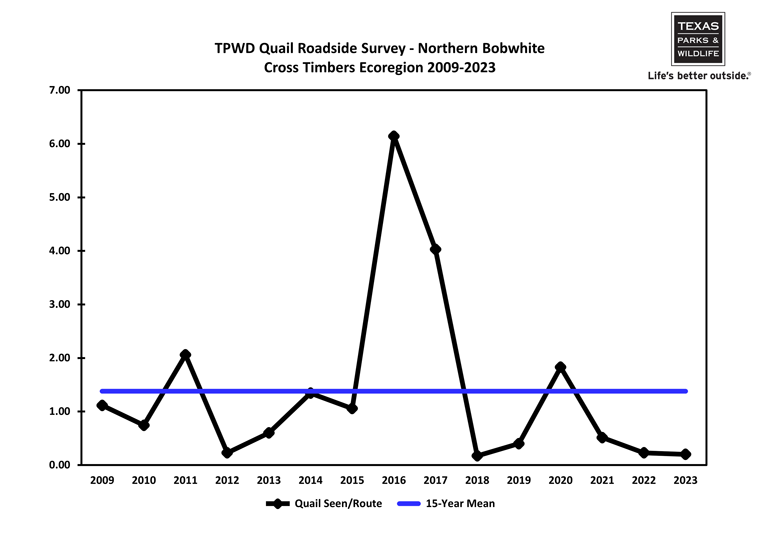
Line graph illustration of the TPWD quail roadside survey results for the Cross Timbers Ecoregion from 2010 to 2024. The mean (average) number of bobwhite quail seen per route for each year is represented by the black line. The 15-year mean (average) is represented by the blue line.
Edwards Plateau
The average number of bobwhites seen per route was 3.39 compared to 1.00 last year. This was above the 15-year mean of 2.96. Limited public hunting opportunities are available through our Annual Public Hunting Permit. As always, scouting ahead and contacting your local biologist are good strategies to ensure a quality experience.
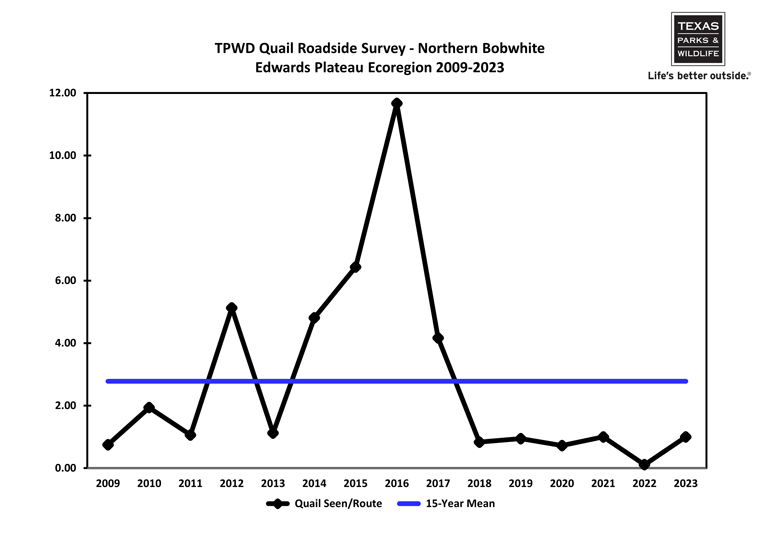
Line graph illustration of the TPWD quail roadside survey results for the Edwards Plateau Ecoregion from 2010 to 2024. The mean (average) number of bobwhite quail seen per route for each year is represented by the black line. The 15-year mean (average) is represented by the blue line.
Gulf Prairies
The average number of bobwhites seen per route was 5.30 compared to 9.60 last year. This was below the 15-year mean of 7.79. Limited public hunting opportunities are available through our Annual Public Hunting Permit. As always, scouting ahead and contacting your local biologist are good strategies to ensure a quality experience.
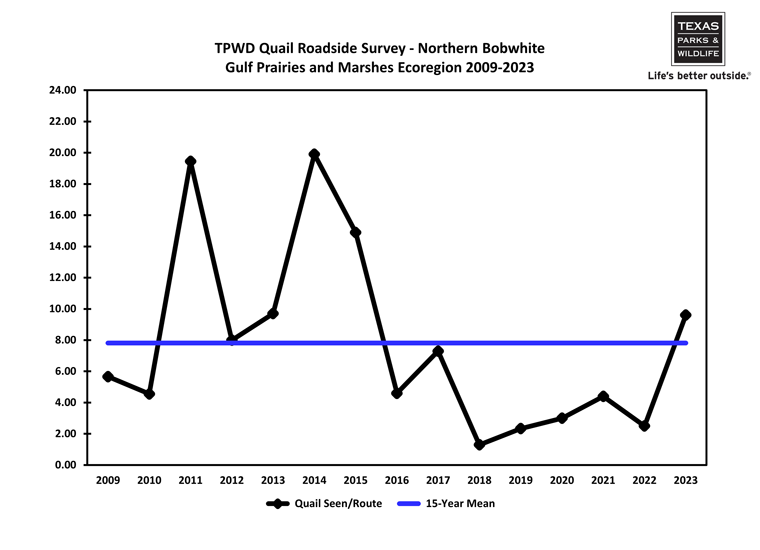
Line graph illustration of the TPWD quail roadside survey results for the Gulf Prairies Ecoregion from 2010 to 2024. The mean (average) number of bobwhite quail seen per route for each year is represented by the black line. The 15-year mean (average) is represented by the blue line.
High Plains
The average number of bobwhites seen per route was 3.78 compared to 3.44 last year. This was below the 15-year mean of 6.31. Public hunting opportunities are available through our Annual Public Hunting Permit. As always, scouting ahead and contacting your local biologist are good strategies to ensure a quality experience.
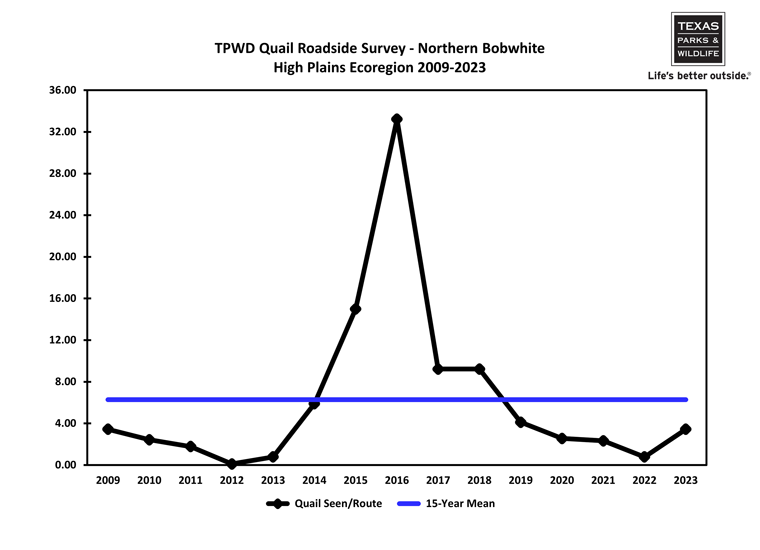
Line graph illustration of the TPWD quail roadside survey results for the High Plains Ecoregion from 2010 to 2024. The mean (average) number of bobwhite quail seen per route for each year is represented by the black line. The 15-year mean (average) is represented by the blue line.
Rolling Plains
The average number of bobwhites seen per route was 16.50 compared to 3.43 last year. This was above the 15-year mean of 11.75. Public hunting opportunities can be found at the Gene Howe and Matador Wildlife Management Areas (WMA). We expect the Matador WMA to provide good hunting opportunities this season, with lower expectations for the Gene Howe. For the fourth year in a row TPWD is offering a Private Lands Quail Hunt in Lipscomb County – applications are due October 15th. Additional hunting opportunities are available through our Annual Public Hunting Permit. As always, scouting ahead and contacting your local biologist are good strategies to ensure a quality experience.
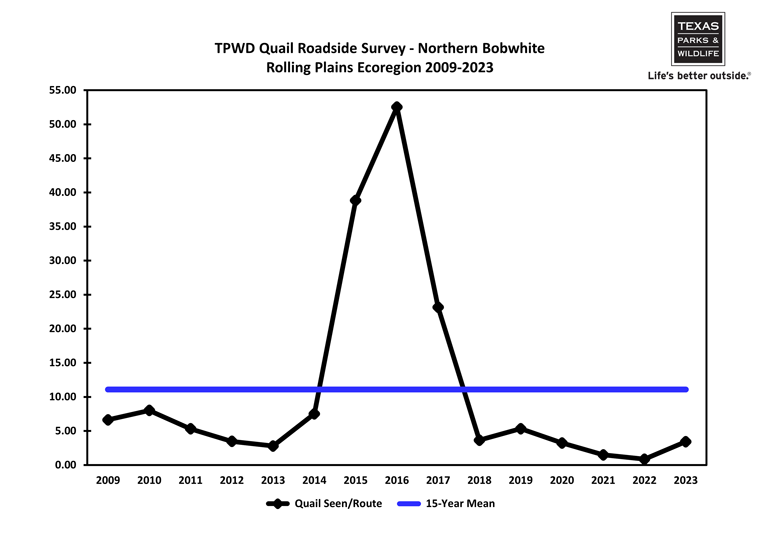
Line graph illustration of the TPWD quail roadside survey results for the Rolling Plains Ecoregion from 2010 to 2024. The mean (average) number of bobwhite quail seen per route for each year is represented by the black line. The 15-year mean (average) is represented by the blue line.
South Texas Plains
The average number of bobwhites seen per route was 9.13 compared to 9.59 last year. This was below the 15-year mean of 9.50. Public hunting opportunities can be found at the Chaparral and James E. Daughtrey Wildlife Management Areas (WMA). We expect these WMAs to provide fair hunting conditions. Additional hunting opportunities are available through our Annual Public Hunting Permit. As always, scouting ahead and contacting your local biologist are good strategies to ensure a quality experience.
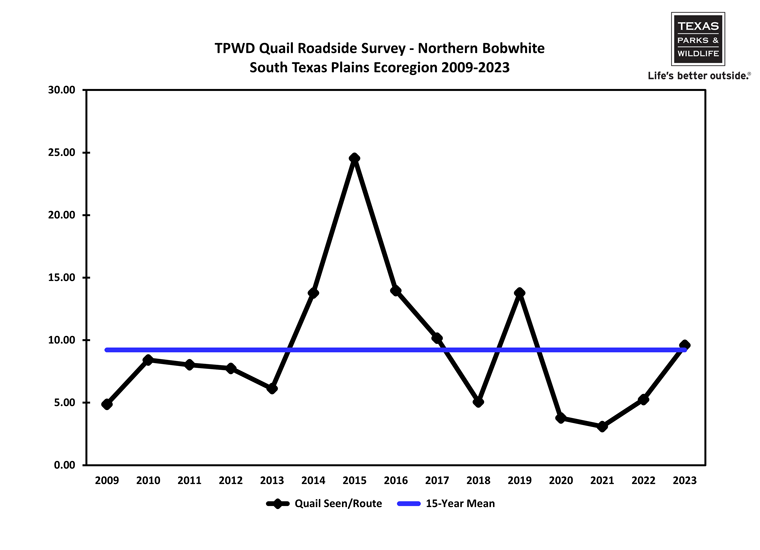
Line graph illustration of the TPWD quail roadside survey results for the South Texas Plains Ecoregion from 2010 to 2024. The mean (average) number of bobwhite quail seen per route for each year is represented by the black line. The 15-year mean (average) is represented by the blue line.